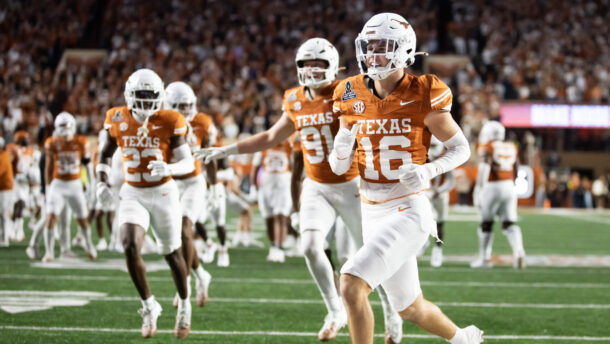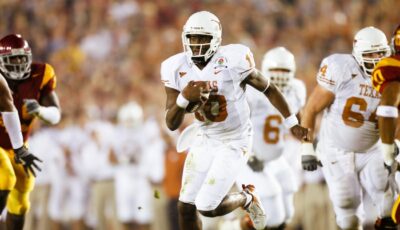The 25 Greatest Football Players in Tennessee History
By Mark Nagi
Last Updated:
Tennessee’s football program might not be considered by some to be a “blue blood,” but the Vols aren’t far off the pace.
The Vols played their first game in 1891. In the 133 years that followed, Tennessee has won 6 national championships and 13 SEC titles. Entering the 2024 season, they have 865 victories, good for 11th all-time in major college football.
Tennessee has played in 54 bowl games (fifth all-time), winning 29 of them (eighth all-time). More than two dozen Vols (22 players and 4 coaches) have been elected to the College Football Hall of Fame. They’ve had 41 consensus All-Americans, and while no Vol has won the Heisman Trophy, four times a Tennessee player has been runners-up. Two of those calls were among the most controversial decisions in the history of the award (but we’ll get into those in a bit).
I’m tasked with putting together the definitive list of the top 25 players in the history of Tennessee football. These are based on their accomplishments while on Rocky Top. I’ve seen games in Knoxville since 1994, so the eye test plays a role for me as well.
Will you agree with this entire list? Of course not! There are at least 15 to 20 players who easily could have been included. It’s difficult to compare players from different eras, or weigh the accomplishments of players who were in Knoxville for a short time, but we’ll do our best.
Top 25 Tennessee Volunteers Football Players
No. 25: Bob Suffridge, OL (1938-1940)
Suffridge, a Knoxville native, is the only three-time All-American in the history of Tennessee football.
He was the anchor of an offensive line that pushed the Vols to three consecutive undefeated regular seasons, three SEC titles in a row and two national championships.
Suffridge was a 190-pound guard upon whom General Robert Neyland counted for his skills as a “brilliant blocker and tackler.”
Suffridge was inducted into the College Football Hall of Fame in 1961.
No. 24: Jalin Hyatt, WR (2020-2022)
Is this recency bias? Maybe. But Jalin Hyatt certainly deserves to be mentioned due to his spectacular 2022 season.
Hyatt caught 20 and then 21 passes in his first two seasons but blossomed as a junior.
His five touchdown catches in the 2022 win over Alabama will be remembered for generations of Tennessee fans to come, but that wasn’t a one-shot deal. Hyatt caught 67 passes for 1,267 yards that year, good enough for second all-time in Tennessee history for a single season in receiving yards.
He was named a unanimous first-team All-American, which makes him eligible to eventually appear on the College Football Hall of Fame ballot. He also won the Biletnikoff Award, which is presented to the nation’s top wide receiver.
Hard to believe for a place nicknamed “Wide Receiver U,” but he was the first Tennessee player to win that award.
No. 23: Travis Henry, RB (1997-2000)
Tennessee has had so many great running backs, but no one has rushed for more yards than Travis Henry.
In his four seasons, Henry gained 3,078 rushing yards, a mark that has stood for nearly a quarter century.
In 1998, Henry was Tennessee’s leading rusher, gaining 970 yards. His performance at the end of the Arkansas game is the stuff of legend. On the game-winning 5-play, 43-yard drive after the Clint Stoerner fumble/Billy Ratliff recovery, Henry got the football on every snap, eventually scoring the touchdown that kept the Vols national title hopes alive.
As a senior in 2000, Henry rushed for 1,314 yards, scored 11 touchdowns and was named first-team All-SEC.
No. 22: Jason Witten, TE (2000-2002)
The Elizabethton, Tenn., standout was recruited as a defensive end but was moved to tight end midway through his freshman season. He wasn’t especially happy with the change, but that was a good call by Phillip Fulmer. As a sophomore, Witten caught 28 passes. One of the lasting images of the 2001 season was when Witten outran the entire Michigan defense for a TD in Tennessee’s Citrus Bowl victory.
As a junior in 2002, Witten caught 39 passes for 493 yards (both remain Tennessee single-season records for tight ends). He was named All-SEC first team that year.
No. 21: Heath Shuler, QB (1991-1993)
Sometimes people forget how good Heath Shuler was in college simply because his pro career didn’t work out. But let me tell you, good reader, Shuler was a serious problem for opposing defenses in college in the early 1990s.
In two seasons as Tennessee’s starting quarterback, Shuler led the Vols to an 18-5-1 record. He was a true dual-threat, rushing for 11 touchdowns in 1992. As a junior in 1993, he threw for 2,354 yards and 25 touchdowns, and finished second in Heisman voting in 1993. He was also named SEC Player of the Year that season.
No. 20: Trey Smith, OL (2017-2020)
During a rough period for Tennessee football, Trey Smith was a terrific ambassador for the Vols on and off the field.
He arrived as a coveted 5-star recruit and became a two-time All-SEC player and an All-American, despite missing time due to career threatening blood clots.
Smith played over 2,500 snaps during his final two seasons, allowing only one sack.
No. 19: Carl Pickens, WR/DB (1988-1991)
He was Tennessee’s best offensive player during a golden age of Tennessee offense.
Pickens had 109 catches for 1,875 yards in 3 seasons, with 13 touchdowns. He also was a standout on special teams, totaling more than 900 combined punt and kickoff return yards.
But Pickens wasn’t only an offensive standout. As a redshirt freshman, Pickens started at free safety, picking off four passes and was named defensive MVP of the 1990 Cotton Bowl.
He was a two-time first-team All-SEC selection and was named first-team All-America in 1991.
Tennessee won SEC titles in 1989 and 1991, thanks in large part to Carl Pickens.
No. 18: Casey Clausen, QB (2000-2003)
He was California cool at a time when the Vols needed a calm presence.
“The Iceman” put up impressive stats during his Tennessee career, throwing for 9,577 yards and 75 TDs in his 3-plus years. But it was the winning that he’s remembered for, going 34-10 as a starter, with a remarkable 14-1 mark in true road games.
Clausen also won at Florida in 2001 and 2003, making him the only Tennessee QB to win in Gainesville in the past 52 years.
No. 17: George Cafego, HB (1938-1939)
Like many players of his era, George “Bad News” Cafego played multiple positions. In addition to halfback, Cafego also played QB and safety, while returning punts and kickoffs.
He was the SEC’s Player of the Year in 1938, and a huge part of Tennessee’s 1939 squad that went unscored upon in the regular season.
Cafego rushed for 1,589 yards in 2 seasons as Tennessee’s starting halfback.
He was inducted into the College Football Hall of Fame in 1969.
No. 16: Joshua Dobbs, QB (2013-2016)
In a Butch Jones offense in which the QB was required to take a massive battering, somehow Joshua Dobbs started each game for Tennessee for over 2 seasons.
Dobbs is the all-time leader in Tennessee history for quarterback rushing yards (2,160) and rushing TDs (32). He also threw for 7,138 yards while leading the Vols to 3 bowl victories.
His “Dobbnail Boot” Hail Mary pass to Jauan Jennings to win the 2016 Georgia game lives on in Tennessee history.
Oh, and did you hear that he was an aerospace engineering major at Tennessee?
No. 15: John Henderson, DT (1998-2001)
He was the SEC’s Defensive Player of the Year in 2000 and a two-time All-American.
“Big John” Henderson didn’t get that nickname lightly. At 6-foot-7, 290 pounds, Henderson took up a lot of space on the Tennessee defensive line. He had 162 tackles as a Vol, along with 20.5 sacks.
In 2000, the Vols allowed only 817 rushing yards, a program record. Henderson’s contributions earned him the Outland Trophy.
Henderson finally appeared on the 2025 College Football Hall of Fame ballot. The nod was long overdue, and he deserves to be the next Vol inducted.
No. 14: Tee Martin, Q (1996-1999)
How hard is it to replace a legend? That’s what Tee Martin had to do when Peyton Manning’s college eligibility ended after the 1997 season.
Martin’s stats might not look too impressive in today’s era. He completed only 55% of his passes at Tennessee. He had 32 TD passes with 16 interceptions.
But Martin was clutch when it mattered the most. The Vols were 22-3 with him as a starting QB, leading Tennessee to an SEC title and its most recent national championship in 1998.
No. 13: Stanley Morgan, WR/RB (1973-1976)
He played in all 46 of Tennessee’s games during his career, splitting time between wide receiver and running back.
Stanley Morgan caught 48 passes for 1,075 yards and eight scores. He rushed 353 times for 1,952 yards and 28 more TDs. He also returned kickoffs and punts with a combined 1,615 yards.
Almost 50 years after his final snap, Morgan remains UT’s all-time career record-holder with 4,642 all-purpose yards.
No. 12: Jamal Lewis, RB (1997-1999)
I hope that you had a chance to watch Jamal Lewis run the football as a true freshman. He rushed for 1,364 yards in 1997, including a 232-yard performance against Georgia, the flagship university of the state he left for Tennessee. Lewis was second-team all-SEC and a freshman All-American.
A torn lateral collateral ligament in the Auburn game cost Lewis most of the 1998 championship season, which was the ultimate sign of just how good that squad was … that they could go 13-0 and win the national championship without Jamal Lewis for most of the year.
He left for the NFL following his junior year with 2,677 rushing yards, which remains fifth all-time in Tennessee history.
No. 11: Hendon Hooker, QB (2021-2022)
If you think Hooker’s ranking is too high, remember: Tennessee’s football resurgence in recent years does not happen if Hooker doesn’t take the field.
He wasn’t recruited to Knoxville by coach Josh Heupel, but he ended being a perfect fit for Heupel’s offense. In two seasons, Hooker threw for 6,080 yards and 58 TDs, completing 69% of his passes. Only 5 times was Hooker intercepted in 632 attempts. He also ran for 1,046 yards and 10 scores.
He was 15-7 as a Tennessee starter, commanding college football’s best offense in 2022.
Had he not torn his ACL in the South Carolina game late that season, he would have been a Heisman finalist and Tennessee might have ended up in the College Football Playoff.
Still, he was named SEC Offensive Player of the Year in 2022, the first Vol to earn that honor since Peyton Manning won it 25 years previous.
No. 10: Condredge Holloway, QB (1972-1974)
One of the most important football players in the history of the SEC, Condredge Holloway is a Tennessee legend.
Holloway became the first Black player to start at QB in the Southeastern Conference. Head coach Bill Battle made the move because starting Holloway gave Tennessee the best chance to win. The Vols went 25-9-2 with Holloway as their starter.
Holloway was years ahead of his time, throwing for 3,012 yards and 18 TDs while also rushing for 966 yards and 9 scores.
Even though this is a football list, Holloway was just as good in baseball.
The Montreal Expos selected Holloway No. 4 overall in the 1971 MLB Draft. Holloway chose Tennessee instead, but he didn’t leave baseball behind while in Knoxville. He batted .353 while becoming Tennessee’s first Black player in that sport.
No. 9: Dale Carter, DB (1990-1991)
He only played at Tennessee for two seasons, but Dale Carter made a huge impact. He was a two-time first-team All-SEC and two-time All-American. In 23 games he made 108 tackles and had 9 interceptions, while picking up a combined 1,652 yards on punt and kick returns. In 1990, he set a UT record (since broken) and led the nation with a kickoff return average of 29.82 yards per attempt.
Carter also had a huge night in New Orleans, picking off two passes and making 10 tackles in the Vols’ Sugar Bowl win over Virginia.
No. 8: Joey Kent, WR (1993-1996)
Peyton Manning would not have his massive success without so many talented players around him. Perhaps the most important player for Manning was Joey Kent.
Nearly 20 years after he graduated, Kent still holds Tennessee career records for receptions with 183, receiving yards with 2,814, receiving touchdowns with 25 and 100-yard games with 15.
Kent led the Vols in receiving for three consecutive seasons and was a two-time first-team All-SEC player and a second-team All-American in 1996. He is best remembered for his 80-yard TD catch to start the 1995 Alabama game, sending Tennessee on its way to a 41-14 win at Legion Field in Birmingham.
No. 7: Hank Lauricella, HB (1949-1951)
Tennessee was still running the single wing under General Robert Neyland when Hank Lauricella was the RB.
He was a two-time All-SEC player and a first-team All-American in 1951. Lauricella lead the Vols to two national championships while passing for 1,105 and 16 touchdowns, rushing for 1,463 yards and 13 scores. He also averaged 36.5 yards per punt … returned punts and kickoffs.
His 75-yard run against Texas in the 1951 Cotton Bowl remains one of the greatest plays in Tennessee history.
Lauricella was a runner-up for the Heisman Trophy in 1951 and inducted into the College Football Hall of Fame in 1981.
No. 6: Al Wilson, LB (1995-1998)
Pick up an encyclopedia and look up the word “leadership” and you’ll find a picture of Al Wilson.
OK. No one has encyclopedias anymore to check my assertion, so you’ll have to take my word for it. Or, you can watch highlights of Tennessee football from the 1997 and 1998 seasons.
Wilson was a first-team all-SEC player those seasons and simply willed the Vols to two SEC titles and the 1998 national championship.
He was had 272 tackles, 11 sacks and 27 tackles for a loss during his career, but it was his performance in the 1998 Florida game that cemented his legend. Wilson had 12 tackles and forced 3 fumbles against the Gators to carry Tennessee to a 20-17 overtime victory.
Tennessee went 34-4 during his three seasons as a starting linebacker.
In 2021, Wilson was inducted into the College Football Hall of Fame.
No. 5: Eric Berry, S (2007-2009)
A strong case can be made that Berry is the greatest safety in college football history.
In 2007, Berry was named a starter in only his second game as a true freshman, no small feat in the Fulmer era. Berry had 86 tackles that year and was a big part of the last UT squad to play for an SEC title.
He was an all-SEC selection three times, the 2008 SEC Defensive Player of the Year, and the only Tennessee player to be named unanimous first-team All-America twice.
Berry was a human highlight film and was elected to the College Football Hall of Fame in 2023.
No. 4: Johnny Majors, TB (1953-1956)
One of the most revered figures in Tennessee football history, the pride of Huntland, Tenn., was a two-time SEC Player of the Year and a first-team All-American. He ran for 1,622 yards, threw for 1,135 yards and scored a combined 27 touchdowns. He also was UT’s punter (averaging over 39 yards per attempt), returned punts and kickoffs and was even credited with two interceptions.
In 1956, Majors led Tennessee to a 10-0 regular-season mark, but Heisman voters gave the award to Notre Dame’s Paul Hornung, despite the Fighting Irish finishing 2-8 that season. Tennessee fans to this day curse that decision. (The award probably should have gone to Syracuse’s Jim Brown … but that’s a discussion for another day.)
In 1977, Majors returned to Tennessee as head coach. The Vols went 116-62-6 in his 16 seasons, and won 3 SEC championships.
In 1987, Majors was inducted into the College Football Hall of Fame.
No. 3: Doug Atkins, DE (1950-1952)
The Humbolt, Tenn., product came to Knoxville to play basketball, but General Robert Neyland convinced him to play football.
That proved to be a pretty good call. At 6-foot-8, Atkins was borderline unstoppable in that era. Opposing quarterbacks often saw passes knocked right back to them. He was a two-time first-team All-SEC player and a first-team All-American in 1952. Atkins was named the SEC’s Player of the Quarter-Century in 1975.
During his time in Knoxville, the Vols went 29-3-1 and won the 1951 national title.
For more proof of his freakish ahead of his time athleticism, Atkins lettered once in basketball and three times in track and field. He placed 2nd in the SEC in the high jump in 1952.
In 1985, Atkins was inducted into the College Football Hall of Fame.
No. 2: Reggie White, DE (1980-1983)
He did not play during an especially memorable stretch of Tennessee football, but Reggie White gave UT fans memories to last a lifetime.
A Chattanooga native, White played 42 games for the Vols, collecting 293 tackles. He had 32 sacks, a program record that stood for 33 years.
In his senior season of 1983, White was at his best, with 100 tackles (72 unassisted) and 15 sacks, all while opposing offensive lines double-teamed him constantly. He was the SEC’s Player of the Year and a consensus All-American.
In 2002, White was inducted into the College Football Hall of Fame. Two years later, White passed away at the age of 43 from a cardiac arrhythmia.
No. 1: Peyton Manning, QB (1994-1997)
The ultimate ambassador for the University of Tennessee athletics program (and for the university itself), the trajectory of UT football changed forever when Peyton Manning chose to play in Knoxville.
Manning was thrust into action in the season opener after Jerry Colquitt tore his ACL at the Rose Bowl. He took over as starter a few weeks later, and held onto that starting spot for the next 3-plus seasons. He became Tennessee’s all-time leading passer with 11,201 yards and 89 touchdowns.
As a senior in 1997 he was a consensus first-team All-American. He also won the Maxwell, Davey O’Brien and Johnny Unitas awards, among others. But the Heisman Trophy went to Michigan’s Charles Woodson, in a decision that rivals the Majors/Hornung controversy of 1956.
Most important, Tennessee went 39-6 with Manning under center and won the 1997 SEC title. Manning’s mere presence helped with the recruitment of many top prospects who helped Tennessee win the national championship one year later.
An absolute no-doubt decision, Manning was inducted into the College Football Hall of Fame in 2017.
Mark Nagi has covered Tennessee athletics for over 20 years. He is the author of “Decade of Dysfunction,” an in-depth look at all that led to the crazy coaching search of 2017 at Tennessee. The book is available on Amazon.






